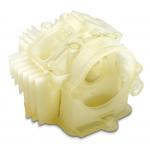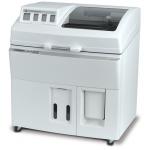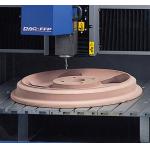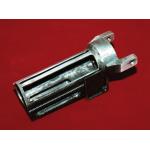RP&M Steps Up the Pace
Vendors show no sign of slowing down in this creative manufacturing industry.
Latest News
April 1, 2006
By Pamela J. Waterman
If you’ve never taken a speed-reading course, now may be the time. You need to be quick to keep up with the continuous wave of new equipment, materials, and improved end-products coming from the vendors of rapid prototyping and manufacturing (RP&M) systems. And we’re talking in just the past year.
|
|
| Courtesy of Stratasys. |
‹ ‹ A complex part created on a Stratasys RP system.
For example, RP&M industry consultant Terry Wohlers said recently that sales of 3D printers for concept models are taking an increased share of the market, with lower-priced products from Stratasys, Z Corp, and 3D Systems leading the way. Wohlers adds, “Several companies that offer additive systems and/or services are shifting some of their focus from prototyping to rapid manufacturing (RM). Improved materials and systems will accelerate the number of RM applications, as well as the number of industries that benefit from it.”
Established Companies, Innovative Actions
Among the recent highlights in the industry from some of its major vendors is the active year 3D Systems has had. Considered the founder of the RP&M business in 1987 with its stereolithography (SLA) process, it will be moving its global headquarters from Valencia, CA, to Rock Hill, SC, in late summer. The move will combine corporate operations, principal R&D activities, and all key support functions in one facility.
On the equipment side, 3D Systems announced four new systems. The modular Viper Pro SLA can run with a dual Resin Delivery Module (RDM) that allows users to run two different materials with a single proprietary imaging and scanning module. The same system can also accommodate a single, extra-large RDM to manufacture parts as large as 1.5 meters long.
3D System’s Sinterstation Pro SLS extends the company’s selective laser sintering product line to produce parts greater than 30 in. long, and includes automated material recycling. The third product line, the InVision 3D-printer series (OEM systems from Solidimension, based on adhering layers of PVC sheets), now has four versions: the SR, HR (high resolution), DP (targeted to the dental market), and LD, the latter at an industry-first price of $14,900.
Beyond its capabilities as a system supplier, 3D Systems has also, in recent years, made a substantial investment in fielding new materials. For example, it announced Accura 25 SL plastic, an opaque-white engineered material that simulates the look and feel of molded polypropylene, for use on all solid-state SLA systems. They also introduced DuraForm EX production-grade plastic for the Sinterstation Pro SLS, offering the toughness and impact-resistance of injection-molded plastics necessary for manufacturing end-use parts.
Through Solidimension, 3D Systems now offers VisiJet HR 200 plastic for the InVision HR 3-D printer, a high-resolution material enhanced for producing intricate, finely detailed patterns for dental labs and jewelry manufacturers.
Fine detail was one of the improvements in Envisiontec’s series of Perfactory additive fabrication systems. With five models based on the Texas Instruments Direct Light Projection (DLP) technology, the new resolution capabilities for hardening the liquid photopolymer (1400 3 1050 pixels) stem from incorporating SXGA+ DLP video light-source chips.
On the materials front, Envisiontec introduced PIC100G, a dark green version of its PIC100 yellow resin, enabling designers (typically in the jewelry industry) to better see full details. PIC100G is suitable for investment casting, with an extremely low expansion ratio and excellent burn-out properties.
Envisiontec also announced its quick-investment-casting material QIC200, suitable for platinum casting. Originally developed for the dental industry, it has been gaining momentum among jewelry casters looking for a casting cycle of less than four hours.
Special Uses and Faster Builds
Over the past year, Solidica has won a number of development contracts to prove the usability of parts made on its Formation Ultrasonic Consolidation machines. Since this technology fabricates pieces layer by layer, typically from sheets of aluminum, it allows embedding of sensor probes during the actual build process. The U.S. Department of Energy’s Office of High Energy Physics has awarded Solidica an SBIR Phase I program to investigate the cooling and monitoring of high-energy electron sources for real-time thermal management.
Another Solidica effort focuses on installing a wide variety of radio frequency sensors directly into metal for installation on the U.S. Marine Corps’ Light Armored Vehicle platform. In this program, the sensors, encased without screws or seams, can provide information like temperature, strain, fluid levels, and oil quality wirelessly to vehicle operators as well as via telematics to remote locations. The program will involve running the sensors on 17 vehicles within a 12- to 18-month period.
A project that takes Solidica’s work beyond typical rapid prototyping applications involves embedding a Freescale Semiconductor 2.4GHz chipset along with specific sensors, such that data can be wirelessly conveyed in real time. This combination also self-identifies the smart components through an added RFID layer. Lastly, the National Science Foundation has awarded Solidica a contract to explore using embedded sensor technology to remotely monitor the “health” of physical structures, including buildings and bridges. Such information could help to predict a potential failure or provide detailed information after a catastrophic event.
At another vendor, Solidscape built on recent successes to announce a 100 percent speed increase for both its T66 and T612 Benchtop 2 3D printers. This RP technology is based on layering micro-droplets of thermoplastic or waxy materials. The systems generally sell to the jewelry and manufacturing industries because of their capability to produce casting master patterns with fine detail and low ash residue. Both models will continue to use Solidscape’s InduraCast and InduraFill materials.
New Services and Lower Prices
As one of the most active companies in the RP world, Minnesota-based Stratasys has recently expanded its product line, lowered system costs, developed new materials, and introduced a new manufacturing service.
Some highlights:
- Introduced Tango photopolymer material with flexible, rubber-like properties for PolyJet systems.
- Launched RedEyeRPM, an online extension of Stratasys’ BuildFDM RP parts service. Customers can now obtain automated, instant quotes, submit orders 24/7, and order PolyJet parts.
- Introduced large-format PolyJet Eden 500V, 350, and 350V systems (from Objet) with larger build envelopes (replacing the Eden 333). New combinations of speed and resolution are also possible.
- Distributes Arcam CAD-to-Metal RP&M systems, which transform titanium powder into solid metal parts.
- Introduced Vantage X, with improved resolution, along with three new materials: PC-ABS blend, PC-ISO, and ABSi.
Dimension 3D Printing Group, a business unit of Stratasys, broke the $20,000 price barrier by dropping the price of its Dimension Breakaway Support Technology (BST) 3D printer to $18,900, and that of the Soluble Support Technology (SST) model (featuring automatic support removal) to $24,900. Both systems use FDM-based ABS materials.
|
|
| Courtesy of Dimension 3D Printing Group. |
› › The Dimension family of 3D printers includes the Dimension BST and Dimension SST—networked, desktop modeling systems designed to build functional 3D models quickly and easily.
Last Fall ZCorp unveiled its ZPrinter 310 Plus system, optimized for high speed and excellent detail at low cost, with a $25,900 price tag; this spring, they dropped the price to $19,900. The 310 Plus offers a resolution that is 50 percent finer than that of the original 310, and operates up to 25 percent faster due to the combination of its new heated build chamber and a new plaster-based composite material, zp130. The zp130 material delivers richer colors, whether used in the single-color Z310 Plus or the full-color Z510 system.
Z Corp also started shipping its ZEdit software to maximize the use of color in 3D printing. Customers can use ZEdit to add notes, edge color, texture maps, and engineering labels, all fitting around contours; the software operates independently of ZPrint software for system operation. And the company announced the availability of Mimics Z software, a joint project between Z Corp and Materialise that allows medical professionals to easily convert MRI and CT scan images into ZPrinter-ready files. Mimics Z is an option bundled with ZCorp equipment.
|
|
| Courtesy of Z Corp. |
‹ ‹ The Spectrum Z510 color 3D printer from ZCorp delivers rich colors using a new plaster-based composite material.
Having merged with Contex Scanning Technology last July, Z Corp still operates independently but is able to take advantage of Contex’s distribution and manufacturing resources. In January ZCorp reported 50 percent growth in revenue for 2005, a growth rate the company believes is more than double that of its nearest competitor.
|
|
| Courtesy of Roland DGA. |
› › Roland continues to develop advanced solutions for the rapid prototyping, reverse modeling, and jewelry design industries based on its subtractive rapid prototyping systems.
Other RP companies are keeping up the pace as well. ProMetal ships both systems and large parts in the direct-metal and casting industries. Roland continues to develop advanced solutions for the rapid prototyping, reverse modeling, and jewelry design industries based on its subtractive rapid prototyping systems. Soligen knows its Parts Now foundry business inside and out, successfully using 3D printing as one aspect of its intricate casting solutions. And Therics keeps adding to its product line of TheriForm synthetic bone graft materials based on its own medically approved 3D printing process.
|
|
| Courtesy of Soligen. |
‹ ‹ Telescope housing cast by Soligen equipment, approximately 18 inches long. Click to enlarge.
So, how long did it take you to read this article? While you were busy, another patent was filed in the RP world. The project you thought difficult to handle yesterday just may have found its solution today, so stay tuned for tomorrow’s headlines.
Contributing Editor Pamela J. Waterman is an electrical engineer and freelance technical writer based in Arizona. You can contact her about this article via e-mail by clicking here. Please reference “RP Steps Up, May 2006” in your message.
Rapid Resources
If you’re considering rapid prototyping or manufacturing for an upcoming project, or just wondering how all the different systems compare, make time to read Printing the Future: The 3D Printing and Rapid Prototyping Source Book by Ed Grenda (revised 2006).
This 200-page hybrid of a book/website/report/bulletin-board offers a very readable overview of additive processing in its many forms, with pros, cons, and reality checks, both technically and business oriented.
Based on Grenda’s years of informative RP-industry postings at The Worldwide Guide to Rapid Prototyping website, Printing the Future not only clarifies the differences among the competing systems and materials but also offers a fascinating range of illustrated case studies with an accompanying goldmine of contact information. A bonus is the related chapter on scanner/digitizer technologies. Don’t let the report-like format fool you: this book is definitely worth far more than its $34.95 price. Check the website for ordering information.
Other books and reports to peruse:
- Wohlers Report 2006: Rapid Prototyping, Tooling & Manufacturing State of the Industry Annual Worldwide Progress Report by Terry Wohlers (WohlersAssociates.com) ($425).
- User’s Guide to Rapid Prototyping by Todd Grimm (2004; sme.org) (non-member $98).
—PM
Companies Mentioned
3D Systems
Rock Hill, SC
Dimension 3D Printing
Eden Prairie, MN
Envisiontec
Ferndale, MI
ProMetal
Irwin, PA
Roland Advanced Solutions Division
Irvine, CA
Solidica
Ann Arbor, MI
Solidimension, Ltd.
Be’erot Itzhak, Israel
Solidscape
Merrimack, NH
Soligen
Northridge, CA
Stratasys
Eden Prairie, MN
Therics
Morrisville, PA
Z Corp.
Burlington, MA
Subscribe to our FREE magazine, FREE email newsletters or both!
Latest News
About the Author
Pamela Waterman worked as Digital Engineering’s contributing editor for two decades. Contact her via .(JavaScript must be enabled to view this email address).
Follow DE










